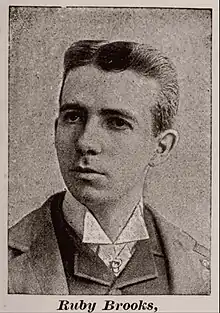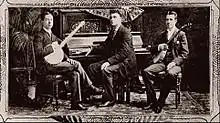
Ruby Brooks (1861 – February 10, 1906) was an American banjoist, composer, and pioneer recording artist, sometimes called "King of Banjoists." He was influential on later banjo players such as Fred Van Eps.[1]
Biography
Reuben R. Brooks was born in Stamford, Connecticut in 1861. He taught himself to play the banjo, receiving no formal instruction. He became famous in 1887 when he performed and won at that year's banjo "Championship of the World" held in Chickering Hall, New York City.[2] There he met and formed a partnership with the runner-up, Harry M. Denton.[2]
Brooks and Denton
They formed the "Brooks & Denton Publishing Co." and citing "of Brooks and Denton" even on his solo recordings.[3][4]
Performances
He gave concerts (often at Chickering Hall) and played in society programs regularly beginning in the late 1880s,[5][6] performing in many varieties ranging from the latest vaudeville tunes to attempts at serious classical music.[7] He repeated as champion at Chickering Hall in 1888 and 1889.[8] He made three separate European tours,[9] performing for various royalty including the Prince of Wales (the future King Edward VII), who was also a banjo player of some skill.[10] By the late 1890s he had mostly ceased to perform in public, finding it more lucrative to give private lessons to wealthy students[2] and to make recordings for the developing phonograph industry. Mr. Brooks recorded regularly for Edison from the late 1890s until his death[11] in New York City in 1906 of throat cancer.[2]

Reception
Although an influence on Fred Van Eps, he is considered by Kaufman and Winans to be inferior to that player, as well as his contemporaries Vess Ossman and Olly Oakley.[12]
Partial list of compositions
- "The Belle of Columbia"
- "Honor Bright"
- "University March"
- "White Star Line"
Partial discography
- Columbia Records
- 254 – The Mosquito Parade (1901)
- 255 – Tell Me Pretty Maiden from "Florodora" (1901) [13]
- 289 – Valse Bleue (1901)
- 293 – Senegambian (1901)
- Edison Records
- 2605 – Darkies Dream[3]
- 2606 – Darkey Tickle[14]
- 2608 – Darkies Patrol[3]
- 2617 – In Old Madrid (re-made 1902)
- 2632 – The Stars and Stripes Forever March (re-made 1902) [4]
References
- ↑ Classicbanjo.com. " Classic Banjo Obituaries – Fred Van Eps ". Retrieved July 12, 2010
- 1 2 3 4 New York Times, "Brooks the Banjoist Dead", February 12, 1906, page 7.
- 1 2 3 Nauck, Kurt. Catalogue: Vintage Record Auction Number 47.
- 1 2 Sage, Glenn. "July 1997 Cylinder of the Month". Retrieved July 12, 2010.
- ↑ New York Times, "PLAYERS OFF THE STAGE.; ENTERTAINING THE GUESTS OF THE LEGION OF HONOR", February 13, 1888, page 8.
- ↑ New York Times, "On the Roof Gardens", July 2, 1893, page 21.
- ↑ Schreyer, Lowell H (2007). The Banjo Entertainers: Roots to Ragtime, A Banjo History . Minnesota Heritage Publishing, Mankato, MN. ISBN 978-0-9713168-9-8.
- ↑ "Great Banjoist Dead". The Pittsburg Press. March 4, 1906. p. 12.
- ↑ Chicago Daily Tribune, July 31, 1890, page 5.
- ↑ Aurora (Illinois) Daily Express, "From Cabin to Parlor – The Banjo of the Plantation Now a Society Favorite", January 24, 1891, page 4.
- ↑ Hoffman, Frank W. (2005). Encyclopedia of recorded sound, Volume 1 . Routledge, New York. ISBN 0-415-93835-X.
- ↑ Winans, Robert B.; Kaufman, Elias J. “Minstrel and Classic Banjo: American and English Connections” ' American Music' Vol. 12, No. 1. (Spring, 1994), page 19.
- 1 2 3 Brooks, Tim, " Florodora Recordings (1901-1902): Discography ", 'ARSC (Association for Recorded Sound Collections) Journal' XXXI (2000) page 66.
- ↑ Nauck, Kurt. Catalogue: Vintage Record Auction Number 41.
External links
Ruby Brooks recordings at the Discography of American Historical Recordings.